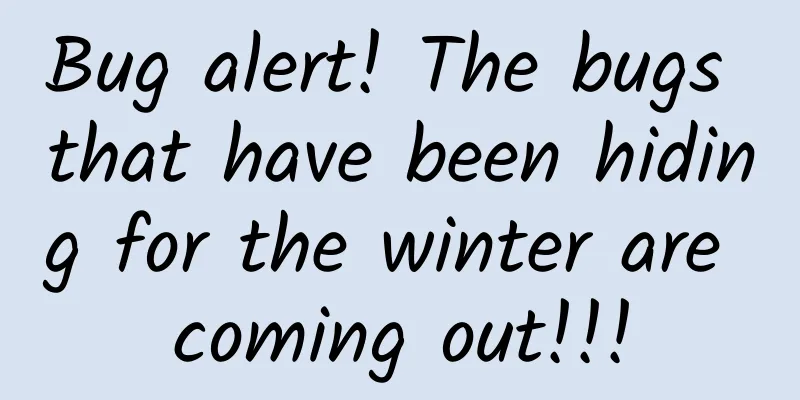Bug alert! The bugs that have been hiding for the winter are coming out!!!

|
Audit expert: Li Weiyang Well-known science writer The "Collection of Explanations of the 72 Seasonal Changes" states: "In the second month, all things come out of the thunderstorm, which is called Jingzhe, and the hibernating insects are awakened." This means that when the weather warms up and the spring thunder begins to sound, the hibernating insects in the ground are awakened. During the Jingzhe season, all things come back to life, and the insects that have been sleeping for a whole winter are about to end their hibernation. Do you know why insects hide in winter? Take Beijing as an example. In summer and autumn, there are many kinds of insects active everywhere, including mantis, wax cicada, dragonfly, cicada, mole cricket, sword-horned grasshopper, ladybug, etc. They seem to have an agreement with winter and hide themselves for the winter. When the weather warms up next year, they will appear again in people's vision. So where do these little guys go in the cold winter? Source of the cocoon of the spiny moth丨Xinhuanet Insects use transformation to survive the winter just as migratory birds migrate to the south to escape the cold and cold-blooded animals hibernate to resist the cold. To fight the cold winter, insects also have their own tricks. They have mastered the method of transformation and survive the winter in different forms such as eggs, larvae, adults, and multiple insects. Source: Wikipedia Overwintering with eggs Among insects, rice leafhoppers and locusts overwinter as eggs. Most locusts do not survive the harsh winter, but their eggs will hatch in the spring. In autumn, before laying eggs, locusts will find a relatively hard place such as a ridge or roadside, and then use the ovipositor at the end of their abdomen to make a small hole in the ground and lay their eggs in the hole. In order to better protect their "offspring", locusts will also secrete glue to tightly wrap their eggs. Source: See watermark Overwinter as larvae Insects such as corn borers and longhorn beetles overwinter as larvae. Corn borer larvae choose corn, sorghum, millet and other stalks and burrow into them to overwinter. Longhorn beetles, which are good at digging "tunnels" in tree trunks, use the inside of the tree trunks as their winter habitat. Corn borer larvae Source: Wikipedia Overwinter as adults Many very small insects overwinter as adults. For example, some aphids often overwinter on young shoots of Asteraceae plants such as prickly lettuce and dandelions on the sunny and leeward slopes of soil mounds. Overwintering in multi-worm form Insects such as mosquitoes and flies that we are very familiar with spend the winter in the form of multiple insects. Mosquitoes have many ways to survive the winter. Some mosquitoes store rich nutrients in their bodies. They rely on these reserves to stay in dark and warm places such as vegetable cellars, indoor corners, haystacks, and tree holes to survive the cold winter. Of course, a large number of mosquitoes also spend the winter in the form of larvae (wrigglers) and eggs. The efforts that insects make for their offspring The above methods are all "transformations" that insects use to cope with harsh environments, but insects do not only "hibernate", they also "summer hibernate". When encountering adverse environments (high temperatures in midsummer or low temperatures in winter), the life activities of insects will stagnate. This stagnation of life can be divided into dormancy and diapause. Hibernation In nature, some insects need to hibernate at a certain stage or age when affected by adverse environments, but insects that end their hibernation period can immediately resume growth and development. Source: Wikipedia Diapause Insects enter diapause before they sense adverse conditions. In this state, even if they are given suitable living conditions, they cannot immediately resume normal growth and development. The factors that cause diapause generally include external factors and internal factors. External factors are generally light cycle, temperature, humidity, food, etc., while internal factors are the insects' own hormones. Among them, light, temperature and humidity are the key factors for insects to end diapause. Hibernation and diapause are both ways of survival that insects have evolved to resist adverse environments, but hibernation is less resistant to adverse environments than diapause. For example, the East Asian locust usually hibernates as eggs in the autumn, and when the autumn is warm, the "overwintering eggs" will continue to hatch, but the hatched nymphs will die as soon as they are born due to the cold winter. Insects' winter trilogy In the cold winter, small insects silently make many preparations to fight against the sudden drop in temperature and the difficult foraging environment. As early as the end of autumn, when the climate began to cool and the average atmospheric temperature dropped to between 8℃ and 10℃, insects began to prepare for winter. Accumulating nutrients is the top priority for insects at this stage. They greedily take in food, which gradually increases the fat content in their bodies until the fat content in their bodies reaches the highest level. Protein and carbohydrates are also constantly stored in other tissues of the insect body. Since insects have a slower metabolism during the winter, the accumulation at this stage is enough to resist the consumption in winter. Source: Wikipedia After "eating and drinking enough", insects enter the second stage in an orderly manner, which is to reduce the water content in their bodies. Under normal living conditions, the water content in insects can reach 70% to 80% of their body weight. The water in their bodies is divided into free water and bound water. Free water is obtained directly by insects from food and the atmosphere, while bound water participates in a series of biochemical changes in the insects' bodies, and the physical properties of the water itself have changed. For insects, a large amount of free water in the body is fatal because free water is easier to freeze. When the temperature drops below zero, the insect's body may freeze or even die due to excessive free water content. Therefore, reducing the free water content in the insect's body greatly improves its cold resistance. Insects that eat fat first and then squeeze out water Source: Wikipedia The last step is the manifestation of insects' thermotropism. As we all know, insects are cold-blooded animals, and their body temperature changes with the temperature. Therefore, in the hot summer, insects will look for cool places everywhere. Then, when the severe cold comes, warm places are the dream places for insects. For example, the multicolored ladybugs that specialize in feeding on aphids will scramble to fly to warmer places such as sheltered wall cracks, haystacks, and warehouses when the weather turns cold. The larvae of the click beetle (wireworm) that live in the soil and hibernate there will march deep into the soil in one go. You should know that the soil temperature at a depth of less than 10 cm is more than 7°C higher than the atmospheric temperature, and the soil temperature at a depth of 20 cm is more than 10°C higher. Therefore, most insects can survive the cold winter relatively safely if they drill into a depth of 10 to 15 cm. Wireworms in the soil Source: Wikipedia In addition to the soil, insects also have excellent shelters under the bark, inside the trunk, and in piles of dead branches and leaves. The temperature in these places is 2℃ to 5℃ higher than the atmospheric temperature. In short, overwintering insects will do their best to find a place to avoid the cold, such as a place 2 cm deep from the trunk, where the temperature is 5℃ to 6℃ higher than outside. The average temperature on the sunny side of the same tree is 7℃ to 8℃ higher than the shady side, so insects prefer to hide in the sunny bark or cracks to hibernate during the winter. In order to survive the cold winter, insects have made various efforts. As the temperature rises, they will gradually wake up, return to nature, and start a vibrant year. |
<<: At the Desert Museum, I was surrounded by coyotes and wild boars
Recommend
World Hepatitis Day | Don’t take it lightly! More than 300 million people are infected nationwide, and it has nothing to do with being fat or thin!
Today (July 28) is World Hepatitis Day. At presen...
From community to e-commerce, how did Xiaohongshu become popular?
Since its establishment in June 2013, Xiaohongshu...
Hexingshe Live Broadcast Account Training Camp - Brand new gameplay, Douyin live broadcast account algorithm logic, precise design of account creation hot products
Hexingshe Live Broadcast Account Training Camp - ...
Ultraman can win the Nobel Prize by fighting monsters!
The battle process between Ultraman and monsters ...
How to promote a new App?
Since I often write about App promotion, friends o...
Falcon wing shape is not enough Tesla Model X "back" ski rack
Recently, according to the website electrek, the ...
Marketing and promotion skills | The marketing behind the crazy rush for Uniqlo’s co-branded T-shirts!
Recently, the Kaws x Uniqlo co-branded T-shirts w...
Retired due to "dementia"! What is this disease that "steals" memory?
Recently, a shocking news came from the film indu...
Subvert your cognition! The most mysterious cells in our body do not belong to us?
© Ranta Images/Getty; Burazin Leviathan Press: Dr...
How can programmers achieve "fast programming speed and few bugs"?
[[131966]] A netizen asked on Quora: How can I tr...
Does Tencent, which is late to the game, still have a chance in OTT?
In July this year, Tencent launched a major inter...
The "oil" on the car seat is actually sweet. If you don't believe it, try it.
Recently, a large number of Beijing workers have ...
Quantitative Learning Cloud Lecture Hall Wang Yan's Four-dimensional Three-first Selection and Following the Banker Basic Training Class 29th
The 29th session of Wang Yan's Four-dimension...
A great guide to job hopping for programmers
[[134505]] May 2015 is already halfway through, a...
The boundary between shape memory and superelasticity: Where does the alloy's "memory" come from?
What kind of sparks will be created when intangib...









